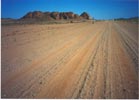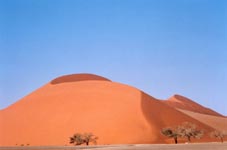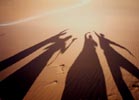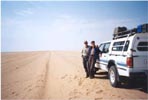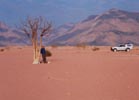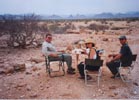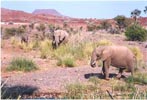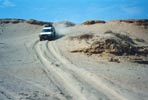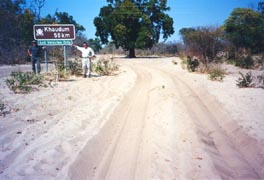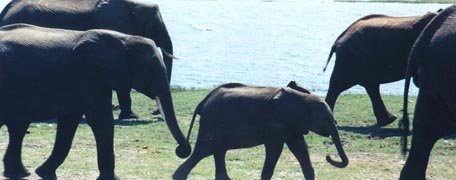SOUTHERN AFRICA
NAMIBIAN NOTES (AND
BOTSWANA)
Click on the photos to see the full size picture
NOTES
* Entering Namibia, we were
immediately overcome by thirst by just looking at the dry landscape.
* The fantastic Fish River Canyon (
a mini Grand Canyon) was overrun by holidaying South Africans. Aside from the
National Park, we stayed at Fish River L.O.D.G.E (Louis' Own Desert Great
Experience- there is no "lodge"). It is private land with road access to the
canyon floor, great canyon camping and walking for a fee. You pay more than in
National Parks, get less in terms of facilities but it was worth
it.
* It was up to Keetmanshoop- the
Quiver Tree forest camp owner feeds cheetah daily (sad to see them in captivity)
but we were more impressed with the meerkats that lived in and around his house.
Keetsmanhoop also spelled the end of Beastie's engine (the 1971 Kombi) and a
rebuilt engine was trucked in from CapeTown.
* Next we headed for Sesriem and the
dunes around Sossusvlei. We "changed horses" at the world's highest dunes.
Cousin Wayne (who we cycled with for 3 weeks last summer and obviously wanted to
right a wrong) was joined by Kathy who we had last seen 17 years ago. The star
arrival was "Magnum", our 4WD twin cab bakkie (pick-up truck). Magnum took over
as we bid Chris and Gabrielle adieu.
* We worked our way through the
impressive Namib-Nauklauft (very dry mountain-desert scenery) through places a
long way from nowhere and on through Swakopmund where tap water costs 2 USD a
cubic metre.
* Up at Cape Cross, home to a
hundred thousand fur seals (hold your nose, penguin colonies seem odourless by
comparison), we headed inland for the great adventure.
Click on the photos to see the full size picture
NOTES
* First stop was the Ugab river and
the Salvadora Widerness Camp (on the White Lady road, 200 metres beyond the
'Goas' sign) in the dry Ugab river bed amongst camel thorn trees. Beautifully
situated and spaced campsites with a tastefully done (flush) toilets and hot
showers (we were roughing it!) provided an incredible backdrop to the arrival of
two desert elephant herds that arrived that evening. With morning coffee in
hand, we experienced a very excited trumpeting young bull charging through the
camp who had been chased off by a larger bull. Bushman paintings, tire repair in
the sad town of Uis, then we scrambled up the top end of a canyon amidst the
pink granite ("so many counter tops" per Kathy) of the Brandberg Mountains.
* A couple of days at the Ugab, then
we passed through Twylfontein (Petroglyphs),a yawn, and down the sandbed of the
Huarib river in time for lunch with a herd of desert elephants (10) digging for
water then drinking and bathing in it (the elephants, not us). We passed nearby
many elephant in the riverbed but we remember the desert giraffe walking over a
sand dune. Remarkable.
* An overnight (very wild camp) in
the middle of nowhere (game and scenery) and onto Purros (the destination is as
good as the journey). Camping under trees in a dry riverbed (delightful shower),
an elephant came to our cocktail hour, throwing in a mock charge (less than 10
paces away) for no extra charge. After watching the incredible giraffe herds,
the following morning found us accidentally amidst a feisty elephant herd
(trapped from behind by another bull that had mock charged us and ahead by
another elephant with young). After applying the "sit still, we were here first"
theory, a side charge by a young aggressive bull forced us to pull out quickly.
We were leading 3 charging elephant by about 20 metres through 4WD bush,
narrowly escaping. Thankfully, we had locked the 4WD hubs in the middle of all
this. Adrenaline surge!
* Thankfully, the "exciting moments"
subsided for the next couple of days before reaching Etosha National Park.
Etosha is indescribable. Where else can you come face-to-face with a zebra or
kudu then watch a jumbo saunter by your vehicle (a burst of adrenaline for the
occupants)?
* Now we are in Winhoek. off to the
Caprivi strip and Botswana...
NAMIBIAN TRAVEL
NOTES
- Best of Fish River Canyon: Dune
buggies (the little beetles that populate the sandy
areas).
- Nambian Campsite advice: always
carry your camera, binoculars and flashlight(with fresh batteries!)...you never
know what you might bump into.
-One of many incredible sights: a
huge elephant bull on his rear haunches reaching for a branch- the "circus"
elephants at Puros.
-Kathy's Erotic tour of Namibia:
Kathy wouldn't dare send films home for processing because of the naughty
pictures. Etosha animals were surprisingly amorous but elephant dongs were a
popular subject.
-Mountain range name in Etosha:
Ondundozonananandana
-Etosha's popular waterholes: the
jostling of vehicles (4WDs, sedans, overland trucks, komis, etc) is only
exceeded by the mixture of animal species elbowing in for a drink of
water.
-Only Namibian disappointment: the
Abu Huab campsite (Twylfontein) attracts overland trucks like flies. We drove
right by and camped wild in a canyon.
-Sesfontein shop: offered a wide
selection of shoe polish, some beer and not much else.
-It must be hot in Africa: Windhoek
is 1700 metres above sea level. This morning, Sheila's breakfast cereal milk
froze in the bowl while she was distracted by guinea fowl.
FOR THE RECORD
Year to date tent nights: 85
Kilometres travelled in Namiba and
RSA (by vehicle): 10,500
Indonesian Banana Index: 10 kilos
for 1 USD (a submission from Rocky touring in Indonesia)
Additional mammals seen and
identified since our last e-mail: - Hhartman's mountain zebra, klipspringer,
slender songoose, small grey mongoose, round eared elephant shrew, steenbok,
giraffe, gemsbok, ground squirrel, blue wildebeest, cheetah, leopard, bat eared
fox, scrub hare, wild cat, cape fox, damaraland dik-dik, cape hare, lion,
black-faced impala, warthog, spotted hyena, black rhino, banded mongoose, honey
badger
****************************
Windhoek,Namibia. August 19,
1999.
*Starting in Windhoek with Wayne
& Kathy in our beloved Magnum 4WD, we headed for Bushmanland via the
Waterburg National Park (a dud).
* In Bushmanland, we camped under
the fantastic Holboom baobob (upside down tree) and were mock charged by yet
another elephant at the Gura waterhole (no fault of ours!). We went for a walk
with the local bushmen who collected their breakfast from the local flora. Later
we gave the bushmen a lift into "town" (Tsumkwe) and they flipped through our
animal field guides, licking their chops. Sheila was unimpressed by their
culinary glee of looking at guinea fowl pictures.
* We headed for Kaudom National
Park, one of the wildest in Africa, ignoring the rule requiring a minimum of 2
vehicles (we had Magnum, the toughest 4WD around). we drove through plenty of
deep sand, enjoyed the best shower in Namibia at Sikereti camp, often waited for
elephant herds to cross the sandy track and visited the very wild Isau waterhole
with its elephant herds, giraffe, roan antelope, vultures, etc. At the
incredible northern Khaudom campsite overlooking a waterhole, Glenn earned the
name "showering with elephants" as a bull elephant tore apart the septic tank a
few metres away from his bush shower. Not for the weak at
heart!
* Entering the Caprivi Strip
(Namibia), we found all the borders were closed because a seperatist group had
stirred things up by trying to capture the main Caprivi town (Katima Mulilo). We
slept while hippos grazed along the Okavango river at Ngapi camp. After visiting
the delightful Mahango reserve, we re-routed into Botswana and followed the
western edge of the Okavango Delta (the size of Switzerland) into
Maun.
* At nearby Nxai Pan (the "x" is
pronounced as a "click"), we drove through more Kalahari sand to visit the
gorgeous savannah and acacia trees in the pan. For 6 hours, we watched a pride
of lions constantly chase down thirsty springbok and impala; we found ourselves
rooting for the lions (unsuccessful that morning).
* Further north along the Chobe
waterfront (near Kasane & Victoria falls) we were stunned by the quantities
of wildlife; it took 2 hours to travel 2 km due to the continuous animal viewing
stops (lions eating a buffalo, giraffe, grazing hippos, sunning crocs, elephants
passing by us within 5 metres, antelope herds, birds,
etc.).
* At the Linyanti campsite (Chobe
National Park), elephants grazed our campsite at dusk. we passed through
elephant alley and plenty more deep sand in the west Savuti area as we made our
way to the Moremi Reserve. Hippos grazed a flashlight beam away (noisy eaters)
and lion roars awoke us during the night at Moremi North Gate
camp.
* In Moremi, Magnum (our 4WD) made
an exciting amphibious crossing (water above the hood) and led us to a
cornucopia of game. One day we watched a male cheetah for 4 hours while he
hunted Impala and warthog; demonstrating the acceleration that Formula I drivers
would envy. The most amazing Moremi sight was a colourful saddlebilled stork
catching and devouring a crocodile (honest; it was a baby
croc).
* Finally after plenty of time in
the bush, we headed back to Windhoek via Ghanzi. We were re-acquainted with
civilization sharing a campsite with a group of touring Italians (lovely people
but sometimes a little too lively) and the thump-thump of the disco, reminiscent
of our nights in Slovakia. Kathy left the tour at Kasane (Vic falls) and Wayne
is heading back to med school. We are looking for a lift to nowhere...staying
with Rudi and Shirley.
TRAVEL NOTES
Best Quote: on asking a local guide
what ostrich eat; " I don't know, but there is plenty of it"
A disturbing quote: while waiting
for the Caprivi borders to re-open; "there hasn't been any shooting for 2
days"
The call of the wild: Wayne's hippo
call (west Caprivi accent) was not well understood by the Moremi
hippos.
Best expression: Thank you very much
in Afrikaans is "baie danke", pronounced "buy-a-donkey".
Safari exercise: driving safaris are
non-physical. You get your daily exercise brushing your teeth and opening tins.
Our upcoming bike trip to Madagascar is going to be difficult at first!
People with good taste: 'Glen Ord'
whiskey is available in Windhoek.
FOR THE RECORD
Number of lions seen to date this
year: 24
Leopards: 3
Cheetah: 3
Wild Dogs: none
Desert elephant: about 40 (total
population is 50-70)
Year to date African kilometres:
15,000
Year to date vehicle punctures:
2
Year to date thermorest
punctures:1
Year to date tent nights:
103
New mammal species spotted: sable,
roan antelope, tree squirrel, hippo, bushbuck, lesser bush baby, waterbuck,
puku, lesser genet, topi.
